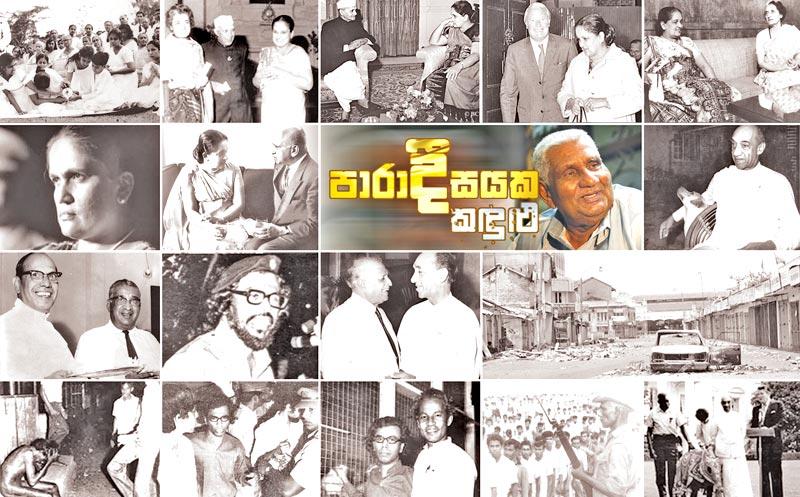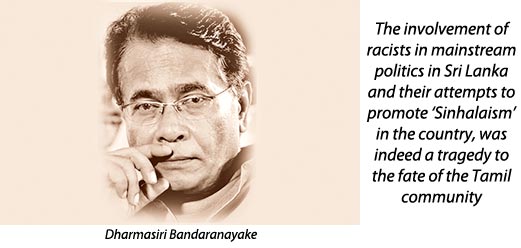
Dharmasiri Bandaranayake’s latest documentary film, ‘Tears in Paradise’ (Paradisayaka Kadulu), consists of the political history of Sri Lanka from the assassination of S.W.R.D. Bandaranaike to the 1983 Black July, emphasizing the dark history of violence released by the Sinhala-Buddhist ethnicity of the country with the patronage of the Sri Lankan Government which was in power at that time.
 ‘Tears in Paradise’ marks the critical historical decision made by Sirimavo Bandaranaike in 1960 as soon as she came into power, rendering the Sinhala language as the official language of the country including in the North and the East which her late husband S. W. R. D. Bandaranaike wanted to do but could not, due to various political reasons. This was the fundamental reason for the rift between the Sinhalese and Tamil community, and the turning point which changed the political landscape of Sri Lanka’s history, forever. The documentary reveals how the short-sighted decision made by Sirimavo Bandaranaike had severely affected the administrative services of the North and East provinces, and how the lives of Tamil civilians were severely disrupted. Although Tamil leaders such as Chelvanayagam held a ‘Sathyagraha’ against Ms Bandaranaike’s arbitrary action, this provided the necessary germ for the thirty year long civil war in the country.
‘Tears in Paradise’ marks the critical historical decision made by Sirimavo Bandaranaike in 1960 as soon as she came into power, rendering the Sinhala language as the official language of the country including in the North and the East which her late husband S. W. R. D. Bandaranaike wanted to do but could not, due to various political reasons. This was the fundamental reason for the rift between the Sinhalese and Tamil community, and the turning point which changed the political landscape of Sri Lanka’s history, forever. The documentary reveals how the short-sighted decision made by Sirimavo Bandaranaike had severely affected the administrative services of the North and East provinces, and how the lives of Tamil civilians were severely disrupted. Although Tamil leaders such as Chelvanayagam held a ‘Sathyagraha’ against Ms Bandaranaike’s arbitrary action, this provided the necessary germ for the thirty year long civil war in the country.
“When examining the political history of the country we realize that the main reason for dragging the country into the three decade civil war was the result of the desperate attempt by the Sinhala majority to convert the Tamil man’s cultural identity into Sinhala. In the documentary I wanted to raise the question of whether we are still ready to accept the identity of Tamil nationality.
“The most serious incident which proves this fact was the burning of the Jaffna Library by people who came to hold the District Development Council elections during the regime of J.R. Jayawardena in 1981. For people in Jaffna, education was the only way out to win their lives and the burning of the Jaffna Library felt as though burning their future,” Dharmasiri Bandaranayake told the Sunday Observer.
The Jaffna Public Library, housing nearly 97,000 rare books, carrying the hope of many Jaffna civilians, was burned to ash on the night of June 1, 1981. The shock experienced by men, women and children in Jaffna that morning is indescribable. That day all Tamils lost a piece of themselves. Despite being the most magnificent piece of architecture, the library was burned down together with the treasure it contained. It was one of the largest libraries in Asia.
This brutal act of violence was carried out, not by a bunch of nameless hooligans, but by hundreds of government officers who came to oversee an election with the guidance of two senior Sri Lankan Cabinet Ministers, Cyril Mathew and Gamini Dissanayake.
In the documentary, as Prof Sivathambi explains, for the Tamil people in Jaffna this was only one example, which proved the grand scheme of massacre in Sri Lanka.
Living in a country that constitutionally displayed mono-ethnicity, from the flag to the official language and the state religion, since its independence, they have lived through multiple state-sponsored pogroms to eradicate the identity of the non-Sinhala-Buddhists, without doubt, an act of massacre.
“There was a trend that the Tamil youth were more likely to become engineers and medical professionals. To prevent that, educational reforms were introduced. The involvement of racists in mainstream politics in Sri Lanka and their attempts to promote ‘Sinhalaism’ in the country, was indeed a tragedy to the fate of the Tamil community.
Every Sinhala-Buddhist in the country is equally responsible for that,” Bandaranayake said.
Rev Father David, a scholar and community leader reportedly died from shock, days after the incineration of his beloved institution. As Prof Sivathambi recalls the Father himself had collected and donated many valuable books to the library.
His statue in the library courtyard is now surrounded by the spirit-soothing greens of local flora. His statue stands tall and reminds the loss suffered by every member of the Tamil nation alive on that day, and each generation born afterwards: it is also a reminder of the unalterable loss of memories, of the life and death of our own community, of the beauty they created as well as of the destruction they may have wreaked.
The centric moment of the documentary was the scene where American diplomats including Ronald Reagan hosted a dinner at White House in 1984 and President J.R. Jayawardena and his officials were the chief guests at the event. Addressing the gathering, President Reagan congratulates JR’s government on the implementation of the ‘free market economic development program’ in Sri Lanka.
The essence of Reagan’s speech was that the J.R. government’s decision to politically implement the neo-liberal program was a blessing for the government. Acknowledging Reagan’s speech, and addressing the gathering JR says that he feels like he’s with his friends. Parallel to this dramatic historic moment, the documentary reveals that it was the time JR was carrying out planned violence against the Tamil community in the country burning both the North and the East and disrupting every livelihood.
A conscientious reviewer of history can identify that a major reason behind the 83 riots was that, although J.R. was an official spokesman for Sinhala Buddhist nationalism, the serious challenge he faced was the inability of his liberal economic and political program to establish an ideological legitimacy in the political ground.
In particular, the historic coalition built in 1956 had come to a decisive end with the 1977 Open Economic Program. The popular opposition in the North against JR’s government was a radical consequence of the Tamil national identity excluded by the ‘56 historical alliances. “Therefore, it is obvious that the violence and social misconduct in the North and the South based on ethnic nationalism after 1977 was one of the results of the liberal economic and political program of JR’s regime.
Although ‘Tears in Paradise’ brings out ample information about the Sinhala-Buddhist’s state repression on Tamils in the country, the history of the rise of the LTTE is not much visible. As Bandaranayake explained he consciously made the decision to pull out the scenes from the documentary because there was a clear foreign involvement behind the rise of the LTTE.
“Especially India was against the liberal economic policies driven by the JR regime and India was behind the rise of the LTTE in the country. In this documentary I tried to emphasise more about the arbitrarily decisions made by JR’s regime which dragged the country to a cliff. I hope to reveal the boom of the LTTE in the next episode of the documentary,” he said.
‘Tears in Paradise’ primarily portrays the violence of the Sinhala Buddhist community launched against the Tamils in the country in various political phenomena. As a representative of the Sinhala Buddhist nation, Bandaranayake believes he deserves the right to criticize his own nation. However, there could be a criticism of not bringing up the violent reaction of the oppressed party.
“I never white wash the brutality of LTTE. The next episode of the documentary will be on this chapter. However, it’s equally important to examine the reasons behind the violence and reasons behind the rise of the LTTE. Through this series of documentary I hope to bring out a broader picture of the political history of Sri Lanka without being biased. I think for a better future it’s important to know our real history,” he said. ‘Tears in Paradise’ was an extension of ‘In search of Paradise,’ a documentary written by Gamini Viyangoda and Dharmasiri Bandaranayake.
